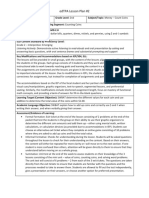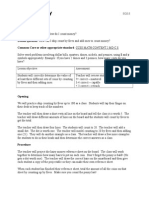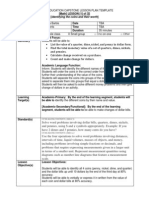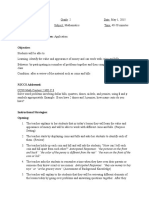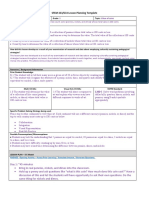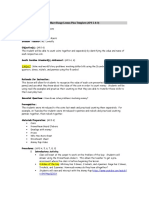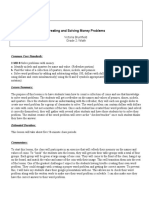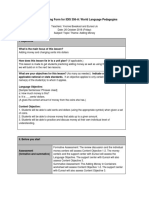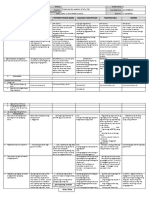Math Unit: Understanding Money: Standard: 1.3.1.4.1
Math Unit: Understanding Money: Standard: 1.3.1.4.1
Uploaded by
cherylynnicoleCopyright:
Available Formats
Math Unit: Understanding Money: Standard: 1.3.1.4.1
Math Unit: Understanding Money: Standard: 1.3.1.4.1
Uploaded by
cherylynnicoleOriginal Title
Copyright
Available Formats
Share this document
Did you find this document useful?
Is this content inappropriate?
Copyright:
Available Formats
Math Unit: Understanding Money: Standard: 1.3.1.4.1
Math Unit: Understanding Money: Standard: 1.3.1.4.1
Uploaded by
cherylynnicoleCopyright:
Available Formats
Math Unit: Understanding Money
Standard: 1.3.1.4.1 Determine the value of any set of pennies, nickels, and dimes.
Day One Objectives: The students will identify pennies, nickels, dimes, and quarters. The students will determine the value of a set of pennies, nickels, dimes, and quarters. The students will explore the value of a set of coins using technology. Direct Instruction: The teacher will introduce the theme Understanding Money to the class. The teacher will begin the lesson by gathering the students on the reading rug. The teacher will then read the book, The Penny Pot by Stuart J. Murphy. This is a wonderful book about a young girl named Jessie trying to come up with 50 cents in order to get her face painted at the fair and the author introduces the concept of counting coins in such a fun and simple way. After the teacher finishes reading the story she will ask what kinds of purchases students have made with coins. They will share ideas in order for the students to use background knowledge to think of times theyve interacted with money. From there the students will be directed back to there seats. The teacher will use the SMART Board to introduce each type of coin. On four separate slides the teacher will go over the values of a penny, nickel, quarter, and dime; making sure to introduce the characteristics of each coin as well. For example: A Penny is U.S. coin worth one cent. It can be written as 1 or $0.0. It is made of Copper and is very smooth. Abraham Lincoln-our 16th president is on the front of the Penny and the Lincoln Memorial is on the back. Guided Practice (with hands-on activities): The teacher will wrap up the SMART Board presentation by having one student from each table come up to the front and grab a plastic tub. In each of the plastic tubs there will be 4 separate baggies, each separately filled with plastic play pennies, dimes, nickels, and quarters. There will also be several sheets of blank white paper [1 per student] and crayons. The teacher will say, now that we have gone over the values and characteristics of each coin, can someone tell me the value of a quarter? The teacher will ask a few questions of the same nature in order to review the concept they have just learned. The teacher will answer any questions or concerns the students have. From there the teacher will give the students 1 minute of play time where they can look at and play with the play coins. After that, she will have the students fold their blank sheets of white paper into four sections. In each section the students will be directed to draw one coin, the coins value, and an observation they made about the coin. The teacher should be circulating the classroom, helping and guiding students with their drawings during this time. When they are finished, the will turn to their shoulder partners and share their papers with each other. The teacher will hang all of the students papers on the bulletin board for them to refer back to throughout the 5-day unit. Independent Practice (paper/pencil): Once the class has put away their previous materials, the students will grab their personal whiteboards and markers. The teacher will tell them they are going to be doing Numbered Heads Together. Using the SMART Board the teacher will show a variety of slides to the whole
class with either a picture of a coin or the amount the coin is worth (for example: 5) on each slide. The students will have to decide the name of each coin being represented on the different slides. They will then belly write their answer on their whiteboard. When the teacher calls Numbered Heads Together, they show their boards to their group members. The students will praise each other if they are all the same and discuss with each other if different until they come up with one answer. Finally, the teacher calls on a number teammate to stand and show teams answer. Ticket Out the Door: The teacher will write 2 questions on the board for each student to answer on their index card known as the Ticket Out the Door. This ticket is required to leave class after the math portion of the day, whether it is going to specials, recess, lunch, or home. The questions for day one will be: 1. Please tell me about an experience you have had using coins. 2. Why do you think learning about coins and how to spend them is important? Assessment: Informal assessment takes place during both guided and independent practice as the teacher walks around the room, observing the students and the work they are accomplishing. Ticket out the door will also be used for informal assessment. Materials: 1. 2. 3. 4. 5. 6. SMART Board/PowerPoint Plastic Tubs Plastic play coins [pennies, nickels, dimes, quarters] Blank sheets of white paper Crayons Index cards
Day Two Objectives: The students will determine the value of a set of pennies, nickels, dimes, and quarters. The students will count on to determine the value of a set of coins. Students will enhance their understanding of coin values. Direct Instruction: The teacher will begin day two by asking questions like, Does anyone remember what the value of a quarter is? Can someone tell me what coin is worth 10? Along with other questions relating to the previous days material in order to get an idea of what the students retained from the previous day. The teacher will then quickly go over the four SMART Board slides that describe each coin, to review what they have learned so far. She will say, Now that we know the value of each coin, we are going to play a game with the coins that will allow us to become more familiar with coins and their values, while also practicing our addition skills! Guided Practice: The students will clear off their desks and a designated student from each table will come up and grab a Money Pot for their table. Students will get into groups of four. Each student will begin the game with 10 pennies. The Money Pot will be placed in the middle of their table. They "pot" will be full of plastic pennies, nickels, dimes, and quarters. The teacher will model how to play the game in front of the students before they play on their own. The teacher will then explain the rules of the game. The rules are as follows: The students will take turns rolling a pair of dice. During each turn, the student will add the number rolled to the amount of money that they started with. The student then adds money from the pot to their pile to create a new total. The student should exchange several smaller coins for larger coins of equal value. To keep track of their money, the students will be writing and calculating each time they roll and how much money they add to their personal money pot in their math journals. The students will play 3 rounds and the winner of each game will be student with the greatest amount of money. Independent Practice: The students will get out their math journals. The teacher will direct the students to draw a picture of the coins they ended up with at the end of the game. The students will also be asked to create a picture and number sentence that shows the addition of all of their coins to total the money at the end of the lesson. Ticket Out the Door: The students will be asked the following questions: 1. Can you please draw me 2 out of the 4 coins we have learned about and write their values. 2. Tell me one thing you learned from todays lesson. Assessment: The teacher can determine whether each child comprehends the values of each coin/dollar, and whether the student comprehends how to add together the coin values while walking around during the guided practice portion of the lesson. Ticket out the door will also be used for informal assessment. Materials: 1. Plastic pennies, nickels, dimes, and quarters
Day Three Objectives: The students will determine the value of a set of pennies, nickels, dimes, and quarters. The students will count on to determine the value of a set of coins. Students will enhance their understanding of coin values. Direct Instruction: Guided Practice: 1. Divide your class into groups of 3 students. 2. Explain the game
instructions to your students. The teacher will write a coin amount for all the students to see. (S)he will then select coins out of the teachers pile that equal the amount written on the board. These coins will be held secretly in the teachers fist or pocket. Each group member will either be the counter, the checker, or the announcer for his or her group. These roles will rotate at the start of each new round of the game. Each group will be given one minute to find a way to represent the coin amount using only the coins in their pile. After their minute is over, the announcer from each group will report back to the class about the coin combination they used to reach the listed amount. Each group will be given one point for being accurate with their coin combination. The teacher will then reveal the combination (s)he used to make the stated amount. An additional point is given to those groups whose choice of coins matches the teacher's selection of coins. 3. Distribute a pile of coins to each group of students. Each student should have the same number of pennies, nickels, dimes and quarters. The teacher will also have the same number of coins in the "teacher's pile".
Independent Practice: Assessment: In the process of play, students will see that there are many possible
solutions to putting coins together to equal a specified amount. Equaling the teacher's choice was guesswork (random choice within a possible set), but accuracy counts for a point as well. The teacher will be observing to see who seemed to have difficulty in adding up coins and who accomplished the task with ease.
Materials:
Day Four
Objectives: The students will count on to determine the value of a set of coins. Students will enhance their understanding of coin values. Students will construct number meanings through real-world experiences and the use of physical material Direct Instruction: Guided Practice: 1. Read "Alexander, Who Used to Be Rich Last Sunday" aloud to
your students. 2. Divide the class into pairs, and give each a set of coin manipulatives. Tell them that you are going to read the book again and that they are to remove the number of coins Alexander spends at each point in the story from their manipulatives. When you've finished the book, check to see if any pair still has "unspent" coins. 3. Hand out a large (12" x 18") piece of paper to each student pair. Ask them to fold the paper into tenths, and then have them draw a box around each of the ten sections. 4. Read the book again, stopping at each "transaction" so the students can record it on the paper. For example, have students write the amount of money Alexander receives from his grandparents in the first box. Then in the second box, have them calculate how much money Alexander has left after he buys all his gum. Continue this way throughout the story until Alexander has spent his last 20 cents.
Independent Practice: Assessment: Were the students successfully able to calculate how Alexander spent
his dollar.
Materials: A copy of the book "Alexander, Who Used to Be Rich Last Sunday" by
Judith Viorst, several sheets of 12-by-8-inch paper, pencils, manipulatives (play or real coins), and calculators.
Day Five Objectives: The students will count on to determine the value of a set of coins. Students will enhance their understanding of coin values. Students will apply mathematics strategies of counting, adding, and subtracting decimal amounts to create change for a dollar. Direct Instruction: Guided Practice: 1. After introducing students to the value of all currently circulating
U.S. coins (including cents, nickels, dimes, quarters, and dollar coins), explain that the students will be exploring how to make change for a dollar. 2. The teacher explains that there are different ways in which to make change. A person can either subtract the cost from the amount given, or they can count up from the cost until they reach the amount given. Today youre going to work with counting up. 3. The teacher asks one student to be the shopper and one to be the clerk to model the activity for the class. The shopper wants to purchase one pencil which (s)he is told costs $0.25. (S)he gives clerk $1.00, and the clerk counts out (aloud) how much change to give back (starting at $.25, they will count $.50, $.75, $1.00), and gives back three quarters. Ask someone else to be shopper and clerk, model another simulation with whole class. Repeat again until students grasp this concept. 4. Provide class with a sheet listing 6 different scenarios to act out in pairs. 5. Once the students seem comfortable with making change, provide each student with 3 more scenarios to work out independently. Provide manipulatives to help students visualize their work. Then ask that students write out number sentences to show how they solved each problem.
Independent Practice: Assessment: Teacher will observe group interactions. Each child will complete a
worksheet which may be formally assessed. The students will also complete an end of the unit test. The test is attached below.
Materials:
1. What is the name of this coin? ______________ How much is the coin worth? _______________
2. What is the name of this coin? ______________ How much is the coin worth? _______________
3. What is the name of this coin? ________________ How much is the coin worth? _________________
4. Draw a line from the coin to the correct amount the coin is worth.
5 cents 1 cent 10 cents
5. How much money do you see? ____________________
6. How much money do you see? _____________________
7. How much money do you see? ___________________
8. Circle the coins that equal one dime.
9. Circle the coins that equal one nickel.
10. Circle the coins that equal one dime.
11. How much money do you see? _________________
12. How much money do you see? __________________
13. How much money do you see? ___________________
14. Find a set of coins that equal the same amount as the ones in the box.
a.
b.
c.
15. Find a set of coins that equal the same amount as the ones in the box.
a.
b.
c.
You might also like
- Edtpa Lesson Plan 2Document4 pagesEdtpa Lesson Plan 2api-465437662No ratings yet
- Math Counting Coins Lesson PlanDocument2 pagesMath Counting Coins Lesson Planapi-448832598No ratings yet
- Kindergarten Math Lesson PlanDocument7 pagesKindergarten Math Lesson Planapi-247285537No ratings yet
- Math Lesson Plan-WeeblyDocument5 pagesMath Lesson Plan-Weeblyapi-489828484No ratings yet
- Diff 510 - LP 1 Hairy Money Tiered by ComplexityDocument8 pagesDiff 510 - LP 1 Hairy Money Tiered by Complexityapi-299976291No ratings yet
- Math Methods Lesson PlanDocument3 pagesMath Methods Lesson Planapi-249226394No ratings yet
- Lean Lexicon-LEX4 - Ebook PDFDocument136 pagesLean Lexicon-LEX4 - Ebook PDFChristian AlvisNo ratings yet
- Lubricant Additives Packages Guide 2015Document2 pagesLubricant Additives Packages Guide 2015dchy100% (4)
- 01 - SRV02 QUARC Integration - Instructor ManualDocument21 pages01 - SRV02 QUARC Integration - Instructor ManualFernando Her R0% (2)
- Lessonplan 1Document3 pagesLessonplan 1api-485134991No ratings yet
- Cutler Solomon Virgil Entryexit FinalDocument9 pagesCutler Solomon Virgil Entryexit Finalapi-286060600No ratings yet
- Isl and CapstoneDocument6 pagesIsl and Capstoneapi-348627392No ratings yet
- Money Lesson Plan5Document2 pagesMoney Lesson Plan5api-312240430No ratings yet
- Lesson One-MathDocument5 pagesLesson One-Mathapi-254944388No ratings yet
- Berman MathlessonDocument3 pagesBerman Mathlessonapi-260047233No ratings yet
- Final Intern CT Observation 2Document6 pagesFinal Intern CT Observation 2api-322204740No ratings yet
- Math Lesson PlanDocument6 pagesMath Lesson Planapi-542785977No ratings yet
- Mental MathDocument2 pagesMental Mathapi-233020448No ratings yet
- Educ 339 Lesson Plan 1Document5 pagesEduc 339 Lesson Plan 1api-293758594No ratings yet
- First Grade Lesson Plan Counting CoinsDocument4 pagesFirst Grade Lesson Plan Counting CoinskimNo ratings yet
- Value of Money LessonDocument4 pagesValue of Money Lessonapi-317786889No ratings yet
- Running Head: Mathematics Lesson PlanDocument6 pagesRunning Head: Mathematics Lesson Planapi-292046301No ratings yet
- Year 2 Maths Money Intro LessonDocument2 pagesYear 2 Maths Money Intro Lessonapi-296657831No ratings yet
- Mathlesson225 MurphyDocument3 pagesMathlesson225 Murphyapi-318477404No ratings yet
- Numbers and Operations LessonDocument3 pagesNumbers and Operations Lessonapi-185932738No ratings yet
- STEM 433/533 Lesson Planning Template: Abigail Sisk 1 Value of CoinsDocument5 pagesSTEM 433/533 Lesson Planning Template: Abigail Sisk 1 Value of Coinsapi-584319081No ratings yet
- Lesson3 Connolly 1Document5 pagesLesson3 Connolly 1api-284357164No ratings yet
- ELD 375 10 Cents Lesson PlanDocument3 pagesELD 375 10 Cents Lesson PlanKellie McGroryNo ratings yet
- Guidedmath 42517Document4 pagesGuidedmath 42517api-354860098No ratings yet
- Mathematics Lesson Plan For 1st GradeDocument5 pagesMathematics Lesson Plan For 1st Gradeapi-302422262No ratings yet
- Cooperative Lesson Plan: 1. Describe The ClassDocument2 pagesCooperative Lesson Plan: 1. Describe The Classapi-357030434No ratings yet
- Tpack Lesson 1Document4 pagesTpack Lesson 1api-334063815No ratings yet
- Money Math: Common Core StandardsDocument5 pagesMoney Math: Common Core StandardscatclarkeCSCCNo ratings yet
- Leffelhannahlessonplan 3Document2 pagesLeffelhannahlessonplan 3api-356878461No ratings yet
- Math Nickels and Pennies SupplementalDocument2 pagesMath Nickels and Pennies SupplementalSarah O'ConnorNo ratings yet
- 1st Grade Math Lesson PlanDocument4 pages1st Grade Math Lesson Planapi-316335409No ratings yet
- Direct Instruction Lesson PlanDocument9 pagesDirect Instruction Lesson Planapi-189534742No ratings yet
- Stem 433 - Final Lesson Plan - Cargen TaylorDocument5 pagesStem 433 - Final Lesson Plan - Cargen Taylorapi-644852511No ratings yet
- Facilitation Lesson Plan 1Document7 pagesFacilitation Lesson Plan 1api-457015094No ratings yet
- Exponent War LessonDocument2 pagesExponent War Lessonapi-210813017100% (1)
- Artauction2014 ReflectionDocument14 pagesArtauction2014 Reflectionapi-232568928No ratings yet
- Kristine Thompson-Math 433 Lesson PlanDocument7 pagesKristine Thompson-Math 433 Lesson Planapi-664972767No ratings yet
- Creating and Solving Money Problems: Common Core StandardsDocument5 pagesCreating and Solving Money Problems: Common Core StandardsVIctoria BrumfieldNo ratings yet
- One, Two, Three. Can You Count Me?: K.CC.B.4Document5 pagesOne, Two, Three. Can You Count Me?: K.CC.B.4Savannah HickleNo ratings yet
- Estimating Sums and DifferencesDocument12 pagesEstimating Sums and Differencesapi-355955362No ratings yet
- Day 4Document3 pagesDay 4api-270448071No ratings yet
- Lesson Plan - Start - Start 3Document12 pagesLesson Plan - Start - Start 3api-455194813No ratings yet
- ABC Economic LiteracyDocument132 pagesABC Economic LiteracyDanicaTasicNo ratings yet
- Make A Commercial ObjectiveDocument10 pagesMake A Commercial ObjectiveJesus VillanuevaNo ratings yet
- Lesson Planning Form For IDIS 356-A: World Language PedagogiesDocument4 pagesLesson Planning Form For IDIS 356-A: World Language Pedagogiesapi-384800531No ratings yet
- PGDPPTT Lesson Plan PH - 202Document32 pagesPGDPPTT Lesson Plan PH - 202Ramya RNo ratings yet
- Standard Lesson Plan FormatDocument2 pagesStandard Lesson Plan Formatapi-526291461No ratings yet
- Unit 5 TemplateDocument2 pagesUnit 5 Templateapi-708699399No ratings yet
- Blended Learning Lesson Plan-5Document4 pagesBlended Learning Lesson Plan-5api-709193335No ratings yet
- Lesson Plan (Numbers)Document29 pagesLesson Plan (Numbers)Dirko SmutsNo ratings yet
- Make A NumberDocument9 pagesMake A Numberjmille44No ratings yet
- Place Value Lesson 1Document5 pagesPlace Value Lesson 1api-201921230No ratings yet
- TCH LRN 409 Project 4Document7 pagesTCH LRN 409 Project 4api-529991456No ratings yet
- Smiggle MathsDocument2 pagesSmiggle Mathsapi-533606711No ratings yet
- 10s Snowball Lesson - LiggettDocument3 pages10s Snowball Lesson - Liggettapi-696490063No ratings yet
- PE and Health Lesson Plan Template: Teacher: Sherry Wyche Grade: k-5 Date: November 25 - November 26, 2013Document2 pagesPE and Health Lesson Plan Template: Teacher: Sherry Wyche Grade: k-5 Date: November 25 - November 26, 2013sherrywycheNo ratings yet
- Magnet Lesson PlanDocument5 pagesMagnet Lesson Planapi-302308635No ratings yet
- Second Grade Lesson Plans: Anti-bullying CurriculumFrom EverandSecond Grade Lesson Plans: Anti-bullying CurriculumRating: 4 out of 5 stars4/5 (1)
- The Holocaust 5-Day SIOP Lesson PlanDocument11 pagesThe Holocaust 5-Day SIOP Lesson PlancherylynnicoleNo ratings yet
- Social Studies Integrated UnitDocument21 pagesSocial Studies Integrated Unitcherylynnicole0% (1)
- Trophies Story: "Across The Wide Dark Sea" Unit DOK Lesson PlansDocument11 pagesTrophies Story: "Across The Wide Dark Sea" Unit DOK Lesson PlanscherylynnicoleNo ratings yet
- Oil Spill Lesson PlanDocument3 pagesOil Spill Lesson PlancherylynnicoleNo ratings yet
- C Markovic He Del 441 Activity PresentationDocument5 pagesC Markovic He Del 441 Activity PresentationcherylynnicoleNo ratings yet
- Lesson One Goals: Rationale:: Tutor: Cherylyn Markovich Tutee: Nathaniel Grade Level: 3 Reading Level: 4Document25 pagesLesson One Goals: Rationale:: Tutor: Cherylyn Markovich Tutee: Nathaniel Grade Level: 3 Reading Level: 4cherylynnicoleNo ratings yet
- "Camp" Expectations and Behavior PlanDocument7 pages"Camp" Expectations and Behavior PlancherylynnicoleNo ratings yet
- ReportDocument1 pageReportcherylynnicoleNo ratings yet
- DLL - All Subjects 1 - Q1 - W5 - D3Document5 pagesDLL - All Subjects 1 - Q1 - W5 - D3Herminia D. LoboNo ratings yet
- Energy Mastery BookletDocument21 pagesEnergy Mastery Bookletapi-422428700No ratings yet
- VedicReport3 7 202011 57 27AMDocument56 pagesVedicReport3 7 202011 57 27AMshekhar singhNo ratings yet
- GaAs HEMTDocument13 pagesGaAs HEMTvchatlanNo ratings yet
- Applied Acoustics: Younes Ramdane, Hamzaoui Nacer, Ouelaa Nouredine, Djebala AbderrazekDocument8 pagesApplied Acoustics: Younes Ramdane, Hamzaoui Nacer, Ouelaa Nouredine, Djebala AbderrazekRamdane YounesNo ratings yet
- Chapter I ErrorDocument10 pagesChapter I ErrorMelakuNo ratings yet
- Method Statement FOR Earth Resistivity TestDocument9 pagesMethod Statement FOR Earth Resistivity TestTARUN100% (2)
- Ranking of Thermal Power Plants Focusing On Air Pollution A NeutrosophicDocument8 pagesRanking of Thermal Power Plants Focusing On Air Pollution A NeutrosophicDesy RsNo ratings yet
- Chapter 7Document29 pagesChapter 7mahmoud sersawyNo ratings yet
- Study Plan For Software EngineeringDocument3 pagesStudy Plan For Software Engineeringabu yusif kargboNo ratings yet
- Thee Splinter TestDocument9 pagesThee Splinter TestPony IsaacsohnNo ratings yet
- Organisational Behaviour Cat 2 Questions and AnswersDocument26 pagesOrganisational Behaviour Cat 2 Questions and AnswersNirmal MNo ratings yet
- Palawan State UniversityDocument20 pagesPalawan State UniversityMengmeng GinfabNo ratings yet
- EBS수능특강 영어 전체범위Document373 pagesEBS수능특강 영어 전체범위gimjangpaNo ratings yet
- 832pm - 59.EPRA JOURNALS,-5781Document5 pages832pm - 59.EPRA JOURNALS,-5781Mani KumarNo ratings yet
- Envisioning Ubiquitous Computing eDocument10 pagesEnvisioning Ubiquitous Computing ezelalemNo ratings yet
- Year 1 Lesson Plan Template 2023Document4 pagesYear 1 Lesson Plan Template 2023azia badduwieNo ratings yet
- In The Ocean 1 1Document76 pagesIn The Ocean 1 1Uğur UzunNo ratings yet
- Anabel Quan-Haase - Lorne Tepperman - Real-Life Sociology - A Canadian Approach (2018) - Libgen - LiDocument492 pagesAnabel Quan-Haase - Lorne Tepperman - Real-Life Sociology - A Canadian Approach (2018) - Libgen - LiYagmur BehrudiNo ratings yet
- Sick Datasheet 1064146Document7 pagesSick Datasheet 1064146ridhaNo ratings yet
- R&Dday Presentation Nov2010Document98 pagesR&Dday Presentation Nov2010CellectisNo ratings yet
- Schedule of Loads: Electrical NotesDocument1 pageSchedule of Loads: Electrical NotesGhian Carlo Garcia CalibuyotNo ratings yet
- William Lilly Fish Stollen by John FrawleyDocument2 pagesWilliam Lilly Fish Stollen by John FrawleytothekenNo ratings yet
- Pedestal - DesignDocument6 pagesPedestal - DesignMatthew KedeNo ratings yet
- Derrida On JoyceDocument84 pagesDerrida On JoyceFrancois RaffoulNo ratings yet
- BUS 6001 - Case Analysis 30 MarksDocument3 pagesBUS 6001 - Case Analysis 30 MarksgloriachebetkoskeiNo ratings yet
- The Wind Wake and Park Effect: Since A Wind Turbine Generates Electricity From The Energy inDocument9 pagesThe Wind Wake and Park Effect: Since A Wind Turbine Generates Electricity From The Energy inKumar PranayNo ratings yet
